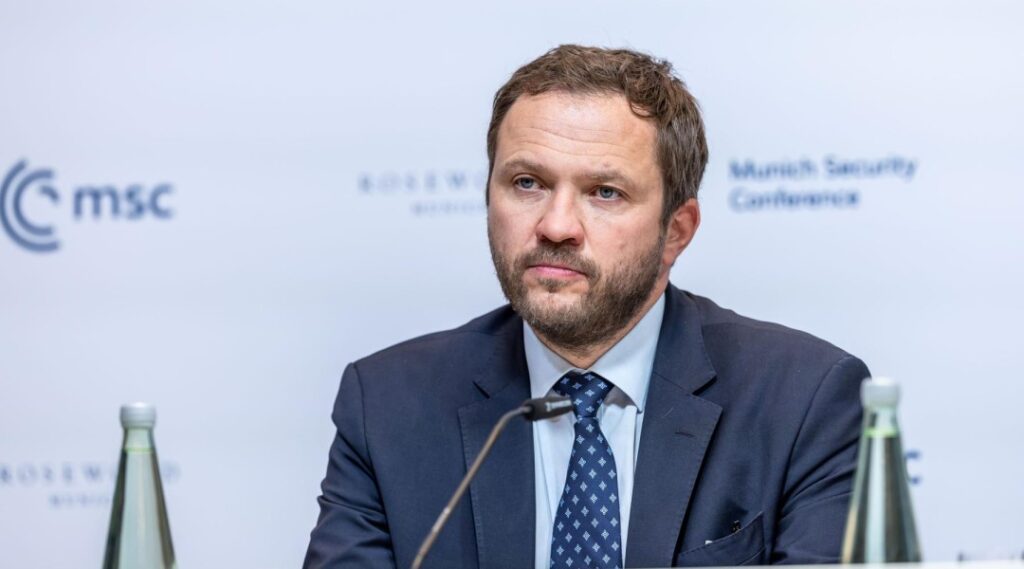Estonia invokes “Munich 1938“ as Trump prepares Putin talks

“We can not let history repeat itself,” Foreign Minister Margus Tsahkna warned on Monday, speaking to Estonian Public Broadcaster’s main radio station Vikerraadio, drawing parallels between Neville Chamberlain’s appeasement and potential Ukraine concessions.
“If we agree to aggression today, we will only encourage similar steps in the future.”
The warning comes as Trump sends mixed signals about Friday’s summit, promising to “try to get some territory back for Ukraine” while simultaneously warning there will be “some swapping, changes in land” — precisely the diplomatic ambiguity preceding 1938’s catastrophe.
Why Alaska echoes Munich’s warnings
Tsahkna’s historical parallel gains urgency from Trump’s contradictory signals about the summit. The president promised Monday to “try to get some territory back for Ukraine” while simultaneously warning there will be “some swapping, changes in land between Russia and Ukraine.”
The Alaska meeting comes after Trump’s self-imposed deadline for Russia to agree to a ceasefire, which expired Friday, without the additional sanctions he had threatened. Instead of punishment, Putin gets a summit — exactly the pattern that encouraged Hitler’s appetite in the 1930s.
“When an aggressor gets what he wants, it increases his appetite,” Tsahkna said. “We must not reward aggression — not in Ukraine or anywhere else. Estonia will never accept state borders changed by force.”
Nordic-Baltic nations draw red lines
The warning escalated into collective action Sunday when eight Nordic and Baltic nations — Denmark, Estonia, Finland, Iceland, Latvia, Lithuania, Norway, and Sweden — released a joint statement with a clear message: “international borders must not be changed by force.”
Their statement declares: “No decisions on Ukraine without Ukraine, and no decisions on Europe without Europe.”
Lithuania’s Foreign Minister Kęstutis Budrys was blunt: “Ukraine’s borders, sovereignty and independence are non-negotiable. From Luhansk to Crimea, every inch belongs to the sovereign nation of Ukraine.”
Latvia’s Foreign Minister Baiba Braže warned, “Russian aggression must neither be rewarded nor justified. To this day, there has not been a single indicator on the part of Russia that would signal its genuine desire for peace and an end to aggression.”
The unified front reflects more profound European anxieties. As Tsahkna noted after Monday’s EU foreign ministers’ meeting, “26 member states expressed very unified positions” while warning that “the Munich Agreement that took place in 1938 cannot be allowed to happen again in Europe.”
Putin’s strategic gambit
Putin sees the meeting as a chance to cement Russia’s territorial gains and keep Ukraine out of NATO. Moscow’s conditions reveal the scope of its ambitions: Putin demands Kyiv cede the annexed regions and Crimea, renounce NATO membership, and limit its armed forces.
The meeting is a diplomatic coup for Putin, who has been isolated since the invasion. The Kremlin sought to portray renewed US contacts as two superpowers resolving global problems, with Ukraine being just one issue.
Europe mobilizes ahead of Alaska
Estonia’s warnings are spurring rapid diplomatic action. Ukrainian President Volodymyr Zelenskyy is expected to join a virtual meeting on Wednesday with Trump, Vice President JD Vance, and EU leaders — coordinated by German Chancellor Friedrich Merz to “discuss how to pressure Moscow ahead of Trump’s meeting with Putin.”
European Commission Vice-President Kaja Kallas warned that Putin wants to “go for the old-fashioned way of… let’s divide the territories and spheres of influence.” The frantic diplomacy reflects Estonia’s core fear: that Alaska could become 2025’s Munich moment without unified Western resolve.
Europe’s “without Ukraine” nightmare
The Baltic states’ urgency stems from fears that Ukraine might be excluded from its fate.
“Nothing can be agreed about Ukraine without Ukraine, and the same applies to Europe more broadly,” Tsahkna insisted. “The meeting between Trump and Putin in Alaska on Friday will be one of the most important meetings in recent decades, and we will work very actively to ensure that our views are represented there.”
As Zelenskyy put it: “Any decisions that are without Ukraine are at the same time decisions against peace. They will not bring anything. These are dead decisions. They will never work.”
Stakes beyond Ukraine
For Estonia and its neighbors, Friday’s meeting tests whether the West learned 1938’s lessons. “Ukraine’s security is Europe’s security,” Tsahkna stressed, which is why Estonia has joined the UK-France coalition, which provides security guarantees to Ukraine.
In Minister Tsahkna’s words, the Alaska meeting will show whether it will be a “Churchill meeting” or a “Chamberlain meeting,” meaning whether Trump chooses Churchill’s resolve or Chamberlain’s appeasement.
The Trump-Putin summit is scheduled for 15 August in Alaska. It follows Trump’s expired deadline for Russia to halt attacks on Ukraine and comes amid reports that Putin has presented territorial concession proposals to the Trump administration.
Read also
-
Russia’s last “Ukraine peace deal” led to Europe’s biggest war since WWII. Here’s why this one could be worse.
-
Nordic-Baltic nations remind before Trump-Putin meeting: international borders must not be changed by force
-
The Times: Europe spent € 72 billion on Ukraine — but has no role in Trump–Putin peace talks. Why?